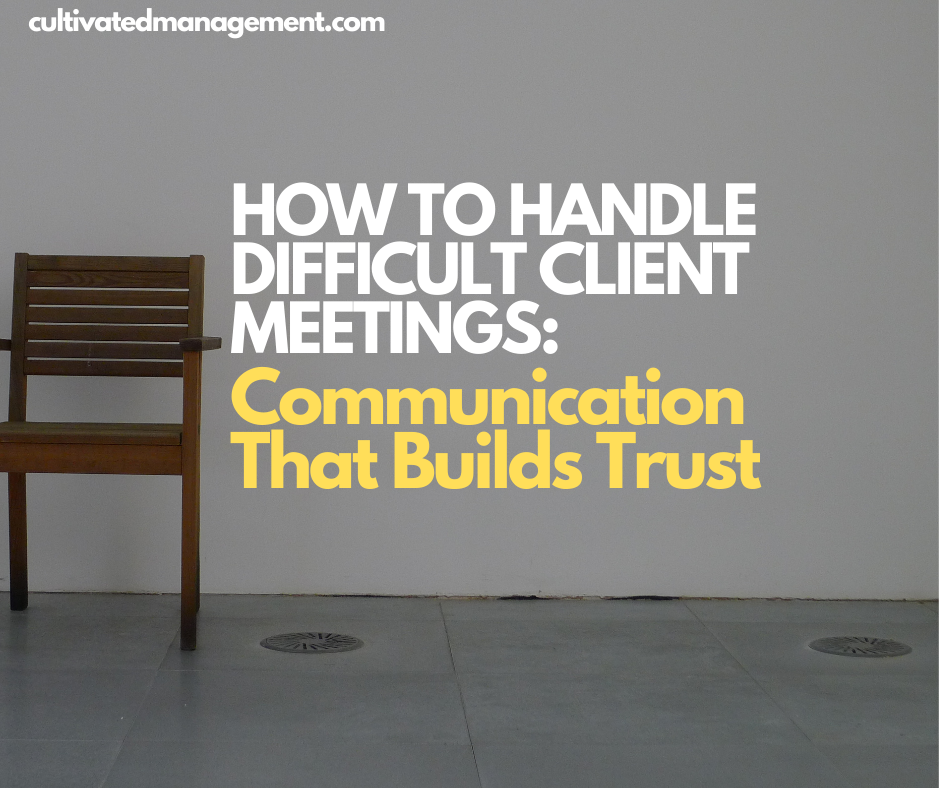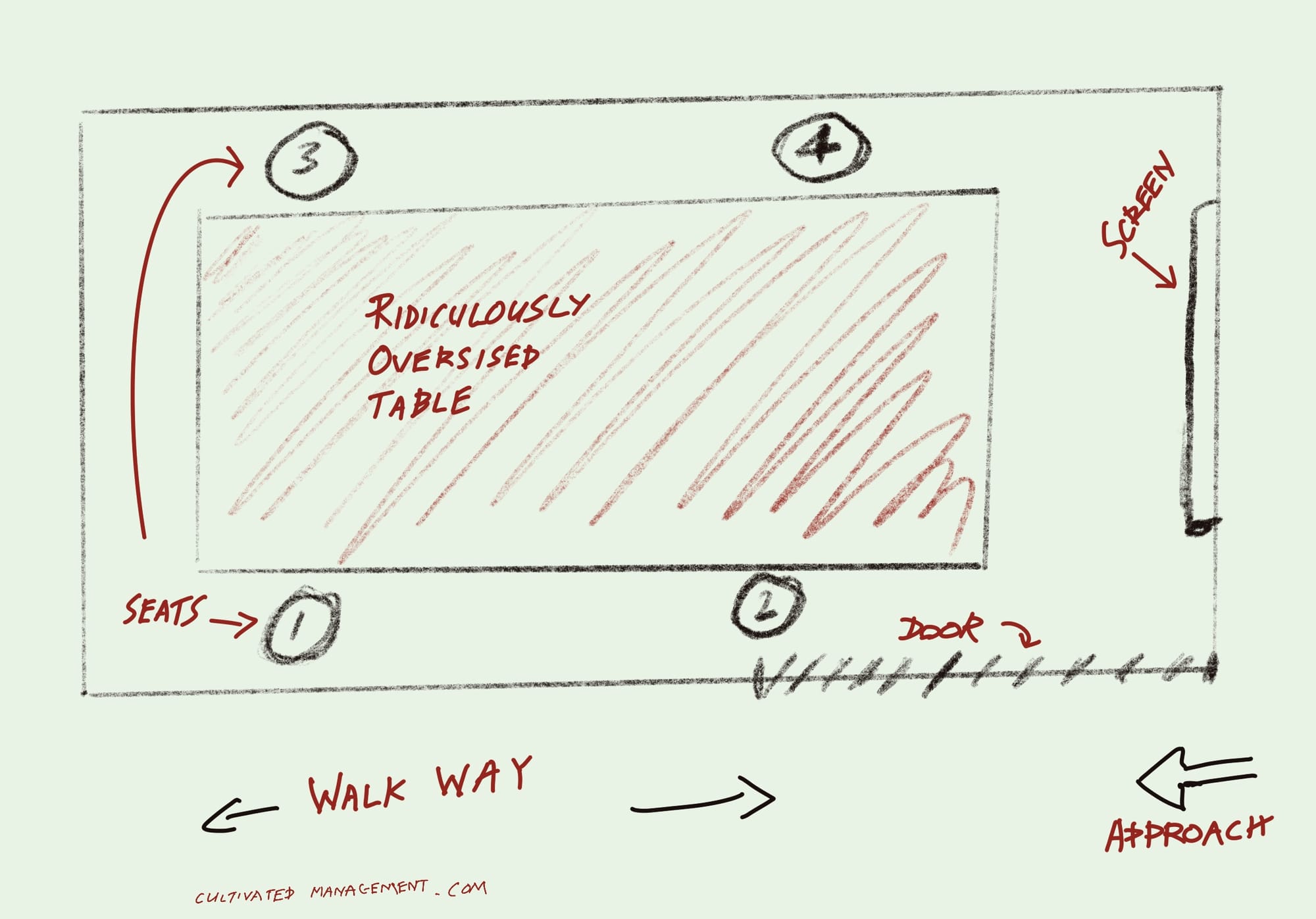
Defusing a Difficult Client Meeting with Simple Communication Moves
A few years ago, I joined a team with a serious reputation problem. They were failing to deliver in a high-profile program, and their internal clients were frustrated, angry, and losing trust.
One of my first tasks was to attend a make-or-break meeting with a major stakeholder who was ready to read us the riot act. On paper, it should have been a brutal encounter. In reality, it turned out very differently.
Here’s how I approached it—and how a handful of simple communication behaviours changed the outcome.
Setting the Stage
The meeting room wasn’t ideal: small, glass-walled, and dominated by an oversized table with only a few stools around it. But environment matters, so I used it to my advantage. I chose a seat (seat 1 in the diagram) that left the chair beside me free (seat 2), making it the easiest place for our client to sit. People naturally build alliances with those next to them, and tension with those opposite.

Beforehand, I aligned with my colleagues on the facts.
Consistency is key—nothing undermines credibility faster than a team with three different versions of events. I also reminded myself of the client’s DISC profile (a high D—direct, action-oriented) and rehearsed my opening.
Preparation isn’t just about what to say—it’s about how to carry yourself under pressure. It's why it's one of my core principles of communication excellence.
The First Impression
When the client approached, I stood tall, arms relaxed, and greeted her with a smile. Research shows we form impressions in less than a tenth of a second (Willis & Todorov, 2006), and smiles not only signal confidence but boost our own feel-good hormones (Psychology Today). They are also a way of showing that you're approachable - and could help to signify competence too - both essential traits of a great first impression.
Trinity of Effective Communication Bundle: Get Zero to Keynote, Workshop Mastery, and the Communication Superpower course—all in one powerful package.
By the time my colleagues scrambled to their feet, I had already shaken her hand and established a tone of warmth and confidence. She chose the chair beside me. Small win but powerful.
Listening First
She launched into her frustrations, directing most of her words toward me — even though technically my boss outranked me. Why? Because I’d set the tone and been the first to speak to her: I was engaged, open, listening - and approachable.
I didn’t interrupt, defend, or deflect. I nodded, took in her words, and let her feel heard. After all, listening is the greatest compliment you can give someone.
Owning Mistakes
When she paused, I didn’t sugar-coat. I apologised for our poor delivery of our service, acknowledged the impact on her team, and repeated her concerns back in my own words. Then I moved to action: here’s what we’ll do, here’s how we’ll fix it, here’s how you’ll see change.
No excuses. No blaming. Just responsibility and a path forward. I ended by asking directly: “Will you give us the chance to make this right?”
Reading the Signals
Throughout, I paid attention to her non-verbal cues—smiles, nods, relaxed posture, times when she was getting annoyed. These weren’t absolutes, but taken together they showed the conversation was shifting. By the end, she was leaning in, calm, and open.
The Outcome
We wrapped up ten minutes early, with genuine thanks from the client. My colleagues were surprised. Even the client later asked why the meeting had gone so differently from what she’d expected.
The answer wasn’t “natural charm.” – I don't have bags of it.
A few years earlier, I couldn’t have handled this. What changed was learning—and practicing—specific communication behaviours until they became second nature:
- Shape the environment (seating, setup).
- Lead with a strong first impression.
- Listen deeply before speaking.
- Own mistakes with humility.
- Frame clear actions and requests.
These aren’t tricks. They’re repeatable skills. And when applied with the right intent, they can turn conflict into collaboration.
If you’d like to build some of these behaviours into your own personal behaviours, I cover them in depth in the Effective Communication Super Power course. Just remember: use them for good, not for evil.
Transform how you communicate—live workshops for teams, self-paced online for individuals.
Bibliography
Edwards, V.V., 2020. How to Pick the Right Seat in a Meeting EVERY Time [WWW Document]. Science of People. URL https://www.scienceofpeople.com/seating-arrangement/ (accessed 7.23.24).
Harker, L., Keltner, D., 2001. Expressions of positive emotion in women’s college yearbook pictures and their relationship to personality and life outcomes across adulthood. Journal of Personality and Social Psychology 80, 112–124. https://doi.org/10.1037/0022-3514.80.1.112
The 9 Superpowers of Your Smile | Psychology Today [WWW Document], n.d. URL https://www.psychologytoday.com/us/blog/changepower/201605/the-9-superpowers-your-smile (accessed 7.23.24).
Wargo, E., 2006. How Many Seconds to a First Impression? APS Observer 19.
Willis, J., Todorov, A., 2006. First impressions: making up your mind after a 100-ms exposure to a face. Psychol Sci 17, 592–598. https://doi.org/10.1111/j.1467-9280.2006.01750.x
